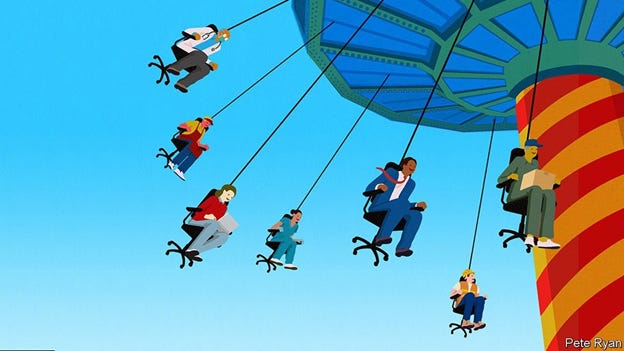Five Reasons To Be Optimistic About The Future of Work
Are we entering a golden age or will workers be taken for a ride?
Hi, I’m Andy Spence and this is the Workforce Futurist Newsletter about the rapidly changing world of work.
This is the 8th regular article delivered to your inbox every other week. Thanks to all those who have shared these articles with your network, this is appreciated.
The Economist has a special report on the Future of Work, called ‘Riding High in a Workers’ World’. Far from being dismal, it’s rather an optimistic outlook.
working life has improved over the ages—and the promise today is as bright as it ever was. Time to get on the ride.
I have summarised five of the reasons given to be positive in this week’s newsletter.
In the very first Workforce Futurist Newsletter on New Year’s Day, Four Work Trends Set to Boom, I started the year positively with more ways to earn and learn, better equity for workers, and a creative boom.
The pandemic has destroyed millions of jobs, causing a drop in employment that was 14 times bigger than after the financial crisis a decade ago. Many ‘key workers’ had to be in public spaces in close proximity with people, and many sadly have died.
So are we entering a golden age for workers, or will workers be taken for a ride?
Things Were Not as Bad as You Thought
From ‘bullshit jobs’ to the ‘precariat’ - it’s easy to find labour market pessimists out there. The Economist report argues that many popular perceptions about the world of work are largely misleading and provides some quantitative data to back this up.
In 2019 BC (Before Covid) nearly two-thirds of Americans said they were completely satisfied with their job security. This is a higher level than in 1999, where the reported levels were less than half.
More people seemed to be enjoying their work. In 2019 Gallup, found that the share of Americans “completely” or “somewhat” satisfied with their jobs was the second-highest since its series began in 1993.
Data shows that America has just had a year containing five of the ten best months for hiring in history. In the spring of 2020, the country's unemployment rate was nearly 15%, it is now just 6%
The Pyjamification of Work
Before the pandemic, Americans spent 5% of their working time at home. By spring 2020 the figure was 60%.
And this seems to go down well with our knowledge workers - there is evidence that the average employee would like to work from home nearly half the time.
The long-term future of work has changed for the better this year because it has become more digitised. Remote working is easing the bottleneck of expensive housing in thriving cities. Home-workers report higher levels of happiness and productivity.
Governments To The Rescue
Governments needed to send cash quickly to families, which they found difficult - it turns out not everyone is on the payroll. Countries have continued to introduce new social-protection programmes long after the acute phase of the first covid-19 lockdowns had passed.
President Joe Biden hopes to use his planned infrastructure splurge to promote unionisation and to pay generous wages. Central banks are worrying ever more about jobs and less about inflation.
An early sign of change was the increase in minimum wages during the previous economic cycle. In richer countries, the minimum wage rose by more than a quarter.
Labour 1 Capital 0
a reversal of the primacy of capital over labour beckons—and it will come sooner than you think.
Economists expect technological investment to bring about faster productivity growth, which means higher wages.
As mentioned in this newsletter, Britain’s Supreme Court ruled that Uber’s drivers were not independent contractors and so were entitled to various in-work benefits, including the minimum wage.
Just as the rise of the gig economy makes it harder to say who is an employee and who is self-employed, so the rise of working from home tests the boundaries where employees’ and employers’ responsibilities begin and end.
With universal safety nets and strong economic growth, workers will have the confidence and bargaining power to experiment and negotiate for themselves.
The Rise of Robots Fallacy
Will Robots Take Our Jobs?
Robots have always been used in the imagination of storytellers to project our greatest fears. In its original Czech, the word ‘Robota’ derives from ‘forced labour’. So read the media scare stories with a pinch of salt, or a spray of WD40.
The Economist reports that American imports of industrial robots fell by 3% in 2020. Rockwell Automation, the world’s largest company dedicated to industrial automation, saw sales decline by 5.5% last year.
You might have heard of the ‘lump-of-labour fallacy’ that there is a finite amount of work, so if some is automated that makes less to go round. In fact, by lowering costs of production, automation can create more demand for goods and services, boosting jobs that are hard to automate.
Well we also have the ‘rise-of-robots fallacy’ that robots will take our jobs – a more helpful view is that these tools that probably boost the creation of better work for us humans.
My Take - Unleashing the Decentralised Workforce
To summarise The Economist report,
we should be positive, invest in very nice pyjamas, embrace the robots, and trust our governments.
I am optimistic too, but for slightly different reasons. I will elaborate in future articles, but for now some initial thoughts :-
It might be global demographics that push the power pendulum back to workers. Wages in the west have been suppressed since the 1980s, with 600 million Chinese workers joining the global workforce. This trend will now reverse with an ageing population and decreasing working-age population. With fewer workers available, the pendulum might swing back to labour over capital.
The workforce is changing rapidly, as I outlined in my essay, Unleashing The Decentralised Workforce. Half the world’s working-age women are not in the formal labour force. And from labourers to playbourers, carers to sharers, artists to exhibitionists – many are earning from their side-hustle. The overlap between entertainment, learning, and work will play out in interesting ways in the 2020s. We are will see an explosion in creativity as many start to achieve their economic potential.
The New Infrastructure of Work – we still use the CV/resume invented by Leonardo Da Vinci in the 15th Century. We have not organised our data well in the world of work and have inefficient work matching systems - you can read my critique and suggestions for fixing it here. We are due an infrastructure upgrade, which will make the labour market more efficient and fairer.
So are we entering a golden age for workers, or will workers be taken for a ride again? Let me know what you think.
The First Crypto Funded $Novel
no other novels have ever been created this way….
First we had the crypto funded $Essay, then the publication platform, Mirror, and now the novel.
Emily Segal has crowdfunded her new novel, Burn Alpha, and raised 25 ETH (worth about $60,000 today) by selling $Novel tokens.
I’m excited about crowdfunding and the world of social tokens because they open up new ideas about how writing can be generated, published and sustained.
This is an exciting use of this technology to build deeper and more direct relationships between writers and readers. In my view this is only the start, as the model can be applied to a broad range of creative, social and entrepreneurial projects.
Feel free to extrapolate wildly and share your ideas and ventures.
Five Principles For Using Technology to Build Successful Organisations
In case you missed it in the week, here are Five Principles For Using Technology to Build Successful Organisations, originally published in TALiNT International Magazine.
If you know anyone in your network who might enjoy this newsletter then please share.
Speakers Corner 📢
I am speaking next week on ‘Blockchain and the Decentralised Workforce’ at People Analytics World on April 21st. The aim is to provide some context to the work trends you read about on the Workforce Futurist Newsletter, in a 30-minute session.
You can benefit from a 25% discount by giving code ANDSPE25
Scribe Spotlight
Hung Lee writes Recruiting Brainfood – the industry newsletter for the talent business.
Over a few years, as an excellent Curator, Hung has consistently found hidden gems, and built an engaged community. The truth is that the content here is much broader than recruitment, and a good read for Workforce Futurists.
Nodes from My Network
Here are three media nodes from my network that you might find interesting.
3 Ways to Maximise Human Skills in our Digital Future – nice summary of a twitter #MercerChat from Danielle Guzman at Mercer.
65+ Global Influencers in HR Tech to Follow in 2021 – always nice to get industry recognition, this is from AIHR Digital.
Digitization of workplaces through 10 perspectives – including an video interview with myself on the potential of people analytics.
Do drop by and say hello, give your views, or tell me what you’re working on. Just reply to this email, or connect on Twitter or LinkedIn.






